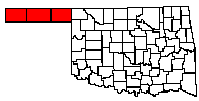|

Welcome
to this OK/ITGenWeb Special Project Page!
No Man's
Land encompasses the OK Panhandle counties of
Beaver,
Texas, and Cimarron.

No-Mans
Land of early Oklahoma history became what is now
known as the Panhandle and touches Kansas, Texas,
New Mexico, and Colorado. Its history begins about
1850 when Texas relinquished claim to
that territory in compromising over the slavery
question. Little or no settlement had been made
there then. The Santa Fe Trail traversed what is now
Beaver County in 1822. An 1850 map shows it as
merely part of the public lands neighboring on the
Cherokee Outlet. It was already a haven for outlaws
for Texas had paid little attention to the extreme
northern part of her territory.
The
type of population in the panhandle are responsible
for its high rank in many respects. There are
practically no Negroes and very few Indians. Those
Indians that are there have settled along the
railroads and have come as enterprising individuals
rather than tribes or bands which were forced to
locate there as is true in the rest of the state.
The few negroes who are there were not slaves to be
released after the Civil War because it was north of
36 degrees and 30' and the latter fact makes the
history of No-Mans Land what it is. The outlaws who
drifted into that territory because it was so long
unorganized and unprotected drifted out when the
opposite condition began to prevail leaving the
original settlers who had come, like the type
already mentioned more as individuals than as
groups, who had gradually filtered in from
settlements in surrounding states and territories.
Probably because there were no large groups led or
driven into this territory statistics show they are
more capable of individual self government than
other peoples to be found in the state. The
population for the whole panhandle rose slowly but
steadily until 1900, sank between 1900 and 1910, and
has risen very gradually since.
One of
the agreements made in 1866 as a result of the Civil
War was the right-of-way to railroads across the
"Indian Country". One of these, the Santa Fe,
followed the old Santa
Fe
Trail across Beaver County. In 1879 the
Jones and Plummer Cattle Trail from Toscasco to
Dodge City first crossed Beaver Creek, and at this
crossing a fur trader built a sod store. Several
years later this place became Beaver City. The name
Beaver, first given to the creek, later to all
No-Mans Land and finally to the present Beaver
County was probably in honor of a chief of the
Choctaw Indians. An 1880 map shows this country a
'Public Land" strip surrounded by states and
territories.
In 1885
and 86 the general tide of immigration into
southwestern Kansas and southeastern Colorado
swarmed over into No-Mans Land. By 1887 the
population had reached 6000 yet there was no way for
the settlers to claim the land upon which they
lived, no way to make marriages legal in the
territory, no laws to govern tax foreclosures, the
organization of corporations, etc. More than that
the desperados and horse thieves who had come there
because of this condition were not pleasant
neighbors for the peaceful settlers who held their
land merely by common consent and good faith. The
main trouble was that during dry years these
settlers often had to leave their holdings for a
time in order to subsist and if someone "jumped
their claim" while they were gone there was no way
of forcing off the intruder.
Under
the circumstances there was nothing the people could
do but organize their own government. The main
hindrance to this was the constant rivalry and
meddling of townsites and ambitious politicians. A
meeting was held in Beaver City on 26 October 1886
which organized a "Claimants Board" to protect land
claims. The inhabitants had only the "squatters
rights" Federal law to work from. In November of the
same year a meeting was held in the sod schoolhouse
in Beaver City for the purpose of manufacturing
"quit claim" deeds at which the foundation was built
for the organization of a new territory known as the
Cimarron Territory.
At the
same time a scheme was being worked on by those who
wished to delay or prevent the settlement of the
"Indian Country" by white people to make No-Mans
Land a part of Kansas.
The
first election in the new Cimarron Territory was
held 22 February 1887. The nine delegates chosen at
this convention met in the same sod schoolhouse on
March 4 and organized a first legislative body of
the Cimarron Territory. This territory was divided
into five counties - Benton, Beaver, Palo Duro,
Optima, and Sunset. Laws were made governing land,
marriages, taxes, foreclosures, etc. What public
property there was at the time had been secured by
private freewill contributions.
The
next three years were marked by the rivalry of
political organizations divided over purely local
issues. J. E. Dale and Orville G. Chase both
reported in Washington, showed credentials, and
asked to be recognized as the official delegate to
Congress from an Organized Territory. Either would
have been seated if it had not been for the
opposition of the other. As it was Congress could
not decide which to recognize and that more than
anything else kept No-Mans Land from eventually
becoming a separate State.
In 1890
the Organic Act which organized the Indian Territory
made No-Mans Land part of that territory. It also
made it all one of seven counties and called it
Beaver County. Beaver County then had a population
of 64,000. Among other things this county then
boasted a newspaper published in Beaver City known
as the Beaver Herald. This paper is still being
published. The town of Rothwell was then a rival of
Beaver City and had caused much of the political
dissension. Beaver City succeeded in becoming the
county seat.

This
item can be found in the vertical files for Texas
County in the Oklahoma Historical Society's Genealogy
Library. It appears to have been part of the Oklahoma
Writer's Project, written on 22 July 1936. The
opinions expressed by the writer of the article in no
way represent the opinions of the coordinator,
OKGenWeb, or the USGenWeb projects. However, it is a
fascinating view of the county from the 1930's.
Thanks
to Mark Adkinson, former host of Texas County
OKGenWeb.

Photographs of No Man's
Land
submitted by Nancy Brister


HELLO
- WELCOME!
My
name is LaRae Halsey-Brooks,
and my daughter,
Eireann Brooks, and I are the Co-Coordinators
for the No Man's Land ITGenWeb Project page.
If
you would like to contribute your information
to this page, please let us know!
If you
are interested in sponsoring a county in the OKGenWeb
Project,
or have questions regarding the OKGenWeb Project,
please contact:
OKGenWeb
State Coordinator: Linda Simpson
Asst State Coordinator: Mel Owings
For more
information, you may also visit the Adopt A County page.

To post
your Queries, Biographies, Bible Records, Deeds,
Obituaries,
Pensions, and Wills, please visit the Ancestry message
board
for No Man's Land.
No
Man's Land Message Board




What's
New?
This
page was last updated November 14, 2023.


Indian
Blanket
- Oklahoma State Wildflower
©
1998-2023 by the No Man's Land Special Project Manager
for the OKGenWeb Project

Links to
websites that are not part of the USGenWeb Project
are provided for your convenience and do not imply any
endorsement
of the websites or their contents by the
USGenWeb Project.
|


